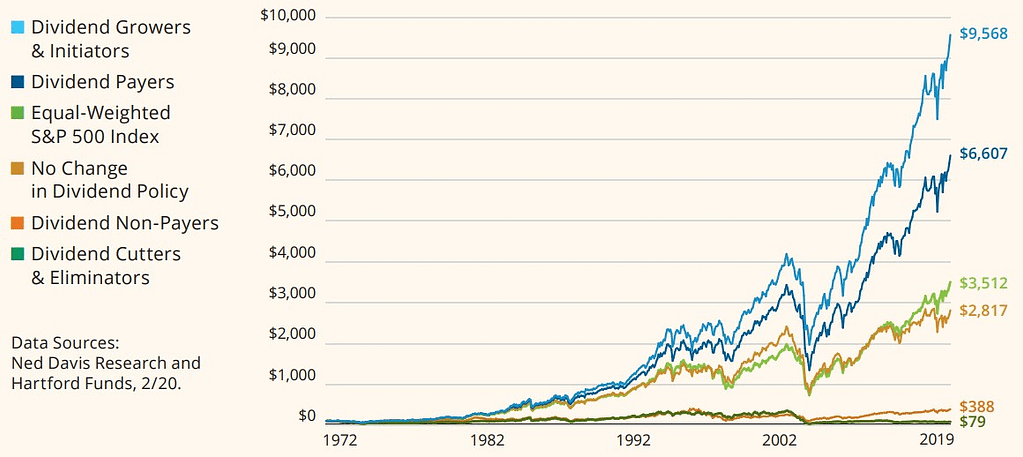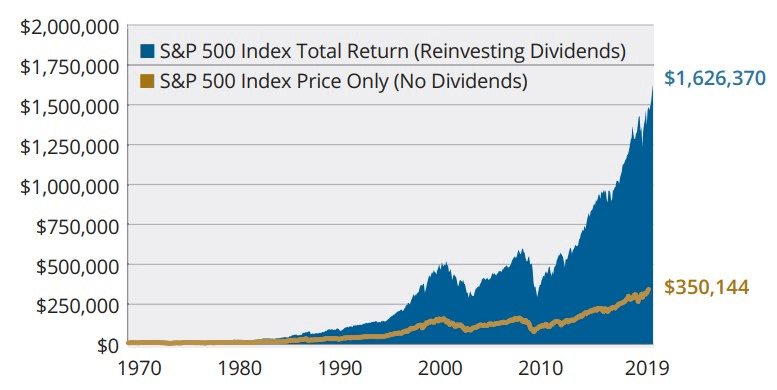Dividend investing is often considered a defensive strategy. Some investors think it’s a bit boring. It doesn’t tend to be in fashion during bull markets when speculators flock to well-known growth stocks and day trading strategies that promise fast returns.
If you prefer a buy and hold strategy but you still want market-beating growth, there’s a variant of dividend investing that you should consider. Dividend growth investing may not offer the excitement of day trading, but over time it’s a proven strategy for both growth and capital preservation.
Why Dividend Stocks?
Dividend-paying companies distribute a portion of their earnings to shareholders, typically on a quarterly basis. The dividend is paid as a flat amount per share, and the dividend yield on your investment is the dividend amount as a percentage of the stock’s price at the time you purchased it.
👉 If you buy a stock at $100/share and the dividend is $3/share, your yield is 3%. Even if the share price goes up or down after you buy it, your yield is the same, because it’s a flat amount per share, not a percentage of the stock price.
👉 If that stock fell to $50 and you bought at that price, the dividend per share would be the same, and your yield would be 6%.
Most growth-stage companies don’t pay dividends. They invest their cash flow in expansion and rely on growth to attract investors. Mature companies with less room to grow turn to dividends to keep investor interest. That doesn’t mean they don’t grow. Many of them do, but their growth rates tend to be less spectacular than those of younger companies.
Dividend-bearing stocks traditionally perform well during bear markets. There are two primary reasons for this.
- Their values are less inflated. These are usually large, well-established companies that get less hype and attention during market upswings. When markets turn down, the high fliers have further to fall.
- Yields rise as stock prices fall. The less you pay for a dividend-bearing stock, the higher the yield will be. As stock prices fall, those yields draw in investors, which supports the price.
That’s a good argument for dividend stocks as a defensive play. But defense isn’t enough: you want your portfolio to grow as well. If you want protection with growth, dividend growth investing may be the strategy you need.
What is Dividend Growth Investing?
Some companies increase their dividend regularly due to their continuous growth. Dividend growth investing means buying dividend-paying stock in these companies.
Dividends involve cash, and that cash has to come from somewhere. The first thing dividend growth investors will look for is continuous annual increases in a company’s cash flow. This is what allows the company to keep paying and increasing its dividend.
🧐 Companies in the S&P 500 that have increased their dividends every year for 25 consecutive years are called dividend aristocrats. As of Jan. 22, 2021, there are 65 Dividend Aristocrats.
👑 An increased dividend every year for 50 years earns a company the status of a dividend king, an honor only 31 companies can currently claim.
Dividend growth investors look to invest in companies with these features.
- Regular dividend increases. Ideally, the annual dividend increase should be equal to or greater than the inflation rate.
- Regular increases in free cash flow. A company needs to increase cash flow to sustain its dividend payments.
- A low dividend payout ratio. The payout ratio is the dividend per share as a percentage of earnings per share. If the payout ratio is too high, the dividend payment may be unsustainable.
- A diverse mix of industries. Holding a diversified portfolio of dividend growth stocks makes it less likely that your holdings will be hit by a single event or industry-wide reduction in value.
- No red flags. Companies with high debt loads or serious legal or regulatory issues may see their ability to pay dividends suddenly reduced.
These criteria select companies for more than just dividends. In order to achieve continuous growth in both dividends and cash flow over an extended period, a company has to exhibit resilience and performance in a wide range of economic and market conditions, including recessions and bear markets.
Dividend Yield vs Dividend Growth
Some investors look for stocks offering the highest dividend yield. That’s a superficially attractive option: higher yields mean more money every quarter, a clear, predictable return on your investment. That impulse is not always one you want to follow for several reasons.
High dividends may mean a low stock price. That’s not always a bad thing, but it’s a reason for caution. The stock price may have been beaten down by events that threaten to interrupt the dividend stream.
The company may be desperate to attract investors. Distressed companies may offer a dividend they can’t sustain in a last-ditch effort to bring in investors and shore up the stock price.
Dividend growth investors often avoid stocks with the highest dividends, focusing instead on stocks with dividends that are reasonably high and growing regularly. There’s a strong historical basis for this preference.

When analysts divided dividend-bearing stocks into 5 groups by dividend size, they found that from 1930 to 2019, the stocks in the second-largest dividend group outperformed the S&P 500 almost 78% of the time. That sums up the goal of dividend growth investing: dividend income with capital growth.
The 1st quintile of high-yielding stocks lagged behind.
One reason for this is the payout ratio we discussed earlier. From 1979 to 2020 the first quintile, the highest dividend payers had a very high payout ratio of 74%. The second-highest quintile had a much more sustainable payout ratio of 41%.
👆 A company that is using too much of its earnings to pay dividends may not have enough cash for its other needs.
Can Dividend Growth Stocks Match Growth Stocks?
As we mentioned earlier, fast-growing stocks generally don’t pay dividends. They pour their free cash back into expansion efforts and rely on their growth rate to attract investors.
Many of the high-flying companies that attract the most attention during bull markets are in this category. Those are the companies that tend to see exponential gains, especially during expansionary periods. Can dividend growth stocks match that performance?
Of course, there’s no way to guarantee the performance of any asset class, but historically “dividend growers and initiators” – companies that started paying dividends and raised their dividends – outperformed other groups by a significant margin over time.

That track record suggests that while dividend growth stocks may not match pure growth plays during a bull market, they are likely to outperform over time.
There’s another strong argument for a dividend growth portfolio over time: reinvestment. If you use a dividend reinvestment plan to buy more stock with your dividends, your portfolio growth rate over time can be dramatically magnified.

Again, the track record is clear: holding selected high-quality dividend-paying stocks and reinvesting the dividends is a powerful tool for building wealth over the long haul.
A Strategy for All Seasons
Investment strategies often change with trends. During a bull market investors flock to high-growth stocks and high-frequency trades. Investors who adopt those strategies often suffer severe losses during market downturns. During and after a bull market many investors turn to value stocks and fundamental analysis.
This often means that investors embrace high-risk strategies at the peak of a bull market, when risk is highest, and embrace conservative strategies during market troughs when growth potential is highest.
This is the exact opposite of Warren Buffet’s famous advice:
Be greedy when others are fearful, be fearful when others are greedy.
Warren Buffet
The problem with Buffet’s approach, of course, is that you have to know when to be greedy and when to be fearful. If you could time markets exactly, you could adopt a defensive portfolio at a market top and an aggressive one at the bottom. Since you can’t time the market exactly, you need a more practical approach.
Dividend growth investing combines defensive and aggressive investments in a single portfolio.
A dividend growth portfolio may not be as aggressive as a pure growth portfolio, and it may not be the most defensive portfolio you can manage. It will combine a strong defensive position with high long-term growth potential.
Blend Your Strategies
Dividend growth investing is a middle-of-the-road strategy blending defensive and aggressive traits. That’s ideal for relatively conservative investors who still want returns.
Some investors may be attracted by the long-term appeal of dividend growth investing but may also want to pursue greater returns during expansionary periods.
If you fall into this category, you have options. Your asset allocation will have a portion of your portfolio in stocks. You can place a percentage of this allocation in a diversified dividend growth stock portfolio and gain resilience.
You could then take another portion of your stock allocation and use it to pursue high-growth assets during bull markets. If you feel that a bull market is reaching its peak, you’ll pull that allocation back and put more money into defensive investment strategies.
This type of strategy lets you pursue the gains that market timing offers while maintaining a base of less risky investments. Don’t forget to protect those aggressive positions with stop loss orders!
These possibilities are examples of strategies that investors use to balance defensive and aggressive approaches. They are not investment recommendations or advice. Always consult a qualified financial advisor before making investments or choosing an investment strategy!























